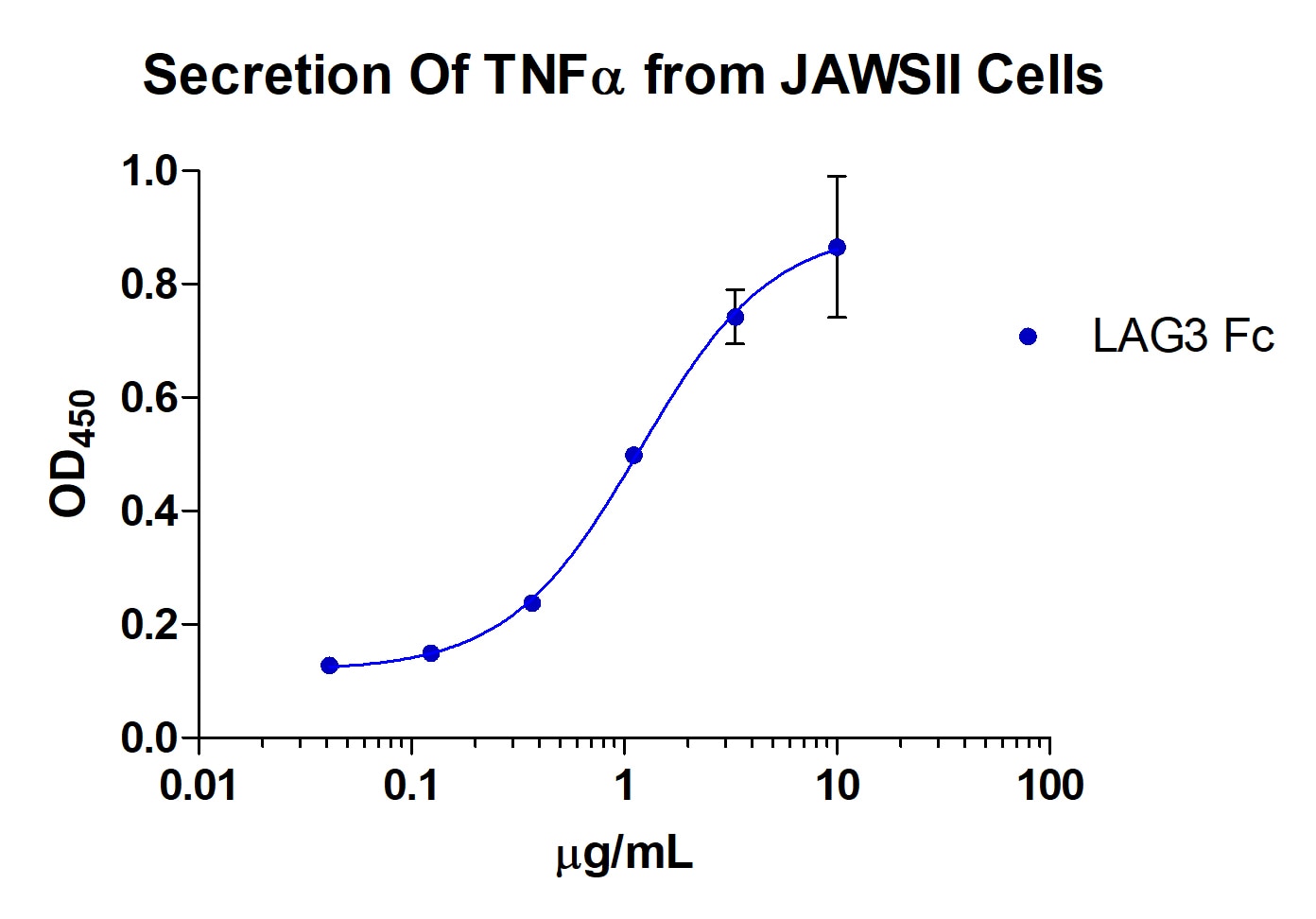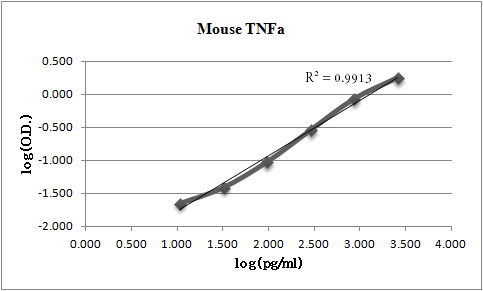Mouse TNF-alpha Biotinylated Antibody Summary
Leu80-Leu235
Accession # P06804
Applications
Mouse TNF-alpha Sandwich Immunoassay
Please Note: Optimal dilutions should be determined by each laboratory for each application. General Protocols are available in the Technical Information section on our website.
Preparation and Storage
- 12 months from date of receipt, -20 to -70 °C as supplied.
- 1 month, 2 to 8 °C under sterile conditions after reconstitution.
- 6 months, -20 to -70 °C under sterile conditions after reconstitution.
Background: TNF-alpha
Tumor necrosis factor alpha (TNF-alpha, TNF- alpha, TNFA ), also known as Cachectin and TNFSF2, is the prototypic ligand of the TNF superfamily. It is a pleiotropic molecule that plays a central role in inflammation, immune system development, apoptosis, and lipid metabolism. TNF-alpha is produced by several lymphoid cells as well as by astrocytes, endothelial cells, and smooth muscle cells. Mouse TNF-alpha consists of a 35 amino acid (aa) cytoplasmic domain, a 21 aa transmembrane segment, and a 179 aa extracellular domain (ECD). Within the ECD, mouse TNF-alpha shares 94% aa sequence identity with rat and 70%-77% with bovine, canine, cotton rat, equine, feline, human, porcine, and rhesus TNF-alpha. TNF-alpha is produced by a wide variety of immune, epithelial, endothelial, and tumor cells. TNF-alpha is assembled intracellularly to form a noncovalently linked homotrimer which is expressed on the cell surface. Cell surface TNF-alpha can induce the lysis of neighboring tumor cells and virus infected cells, and it can generate its own downstream cell signaling following ligation by soluble TNFR I. Shedding of membrane bound TNF-alpha by TACE/ADAM17 releases the bioactive cytokine, a 55 kDa molecular weight soluble trimer of the TNF-alpha extracellular domain. TNF-alpha binds the ubiquitous 55-60 kDa TNF RI and the hematopoietic cell-restricted 80 kDa TNF RII, both of which are also expressed as homotrimers present on virtually all cell types. Both type I and type II receptors bind TNF-alpha with comparable affinity, although only TNF RI contains a cytoplasmic death domain which triggers the activation of apoptosis. Soluble forms of both types of receptors are released and can neutralize the biological activity of TNF-alpha.
Product Datasheets
Citations for Mouse TNF-alpha Biotinylated Antibody
R&D Systems personnel manually curate a database that contains references using R&D Systems products. The data collected includes not only links to publications in PubMed, but also provides information about sample types, species, and experimental conditions.
33
Citations: Showing 1 - 10
Filter your results:
Filter by:
-
Alleviation of LPS-Induced Inflammation and Septic Shock by Lactiplantibacillus plantarum K8 Lysates
Authors: Gayoung Kim, Kyeong-Hun Choi, Hangeun Kim, Dae-Kyun Chung
International Journal of Molecular Sciences
-
Peripheral Taenia infection increases immunoglobulins in the central nervous system
Authors: S Van Belle, A de Lange, H Tomes, R Lucas, V Naidoo, JV Raimondo
International journal for parasitology, 2021-03-20;51(8):685-692.
Species: Mouse
Sample Types: Tissue Homogenates
-
Interleukin (IL)-25 suppresses IL-22-induced osteoclastogenesis in rheumatoid arthritis via STAT3 and p38 MAPK/I&kappaB&alpha pathway
Authors: HK Min, JY Won, BM Kim, KA Lee, SJ Lee, SH Lee, HR Kim, KW Kim
Arthritis Research & Therapy, 2020-09-23;22(1):222.
Species: Human
Sample Types: Synovial Fluid
-
A Bcr-Abl Inhibitor GNF-2 Attenuates Inflammatory Activation of Glia and Chronic Pain
Authors: GJ Song, MH Rahman, MK Jha, DP Gupta, SH Park, JH Kim, SH Lee, IK Lee, T Sim, YC Bae, WH Lee, K Suk
Front Pharmacol, 2019-05-20;10(0):543.
Species: Mouse
Sample Types: Cell Culture Supernates
Applications: ELISA Detection -
Modulation of the Sigma-1 Receptor-IRE1 pathway is beneficial in preclinical models of inflammation and sepsis.
Authors: Dorian A. Rosen, Scott M. Seki, Anthony Fernández-Castañeda, Rebecca M. Beiter, Jacob D. Eccles, Judith A. Woodfolk et al.
Science Translational Medicine
-
Interferon-gamma regulates inflammatory cell death by targeting necroptosis in experimental autoimmune arthritis
Authors: SH Lee, JY Kwon, SY Kim, K Jung, ML Cho
Sci Rep, 2017-08-31;7(1):10133.
Species: Mouse
Sample Types: Cell Culture Supernates
Applications: ELISA Development (Detection) -
Anti-inflammatory Effects of the Natural Compounds Cortex Phellodendri and Humulus japonicus on Pelvic Inflammatory Disease in Mice
Authors: Y Oh, YS Kwon, BD Jung
Int J Med Sci, 2017-07-18;14(8):729-734.
Species: Mouse
Sample Types: Tissue Homogenates
Applications: ELISA Development (Detection) -
LRP1 expression in microglia is protective during CNS autoimmunity
Authors: Tzu-Ying Chuang, Yong Guo, Scott M. Seki, Abagail M. Rosen, David M. Johanson, James W. Mandell et al.
Acta Neuropathologica Communications
-
Oryza sativa (Rice) Hull Extract Inhibits Lipopolysaccharide-Induced Inflammatory Response in RAW264.7 Macrophages by Suppressing Extracellular Signal-regulated Kinase, c-Jun N-terminal Kinase, and Nuclear Factor-?B Activation
Authors: Yoonsook Kim
Pharmacogn Mag, 2016-10-01;12(48):295-301.
Species: Mouse
Sample Types: Cell Culture Supernates
Applications: ELISA Development (Detection) -
A novel role for protein tyrosine phosphatase 1B as a positive regulator of neuroinflammation
Authors: GJ Song, M Jung, JH Kim, H Park, MH Rahman, S Zhang, ZY Zhang, DH Park, H Kook, IK Lee, K Suk
J Neuroinflammation, 2016-04-19;13(1):86.
Species: Mouse
Sample Types: Cell Culture Supernates
Applications: ELISA Development (Detection) -
Glimepiride reduces CD14 expression and cytokine secretion from macrophages.
Authors: Ingham V, Williams A, Bate C
J Neuroinflammation, 2014-06-21;11(0):115.
Species: Mouse
Sample Types: Cell Culture Supernates
Applications: ELISA Development (Detection) -
Rift Valley fever virus infection induces activation of the NLRP3 inflammasome.
Authors: Ermler M, Traylor Z, Patel K, Schattgen S, Vanaja S, Fitzgerald K, Hise A
Virology, 2013-12-03;449(0):174-80.
Species: Mouse
Sample Types: Cell Lysates
Applications: Western Blot -
Regulator of calcineurin 1 suppresses inflammation during respiratory tract infections.
Authors: Junkins R, MacNeil A, Wu Z, McCormick C, Lin T
J Immunol, 2013-04-15;190(10):5178-86.
Species: Mouse
Sample Types: BALF
Applications: ELISA Development (Detection) -
Response patterns of cytokines/chemokines in two murine strains after irradiation.
Authors: Zhang M, Yin L, Zhang K, Sun W, Yang S, Zhang B, Salzman P, Wang W, Liu C, Vidyasagar S, Zhang L, Ju S, Okunieff P, Zhang L
Cytokine, 2012-01-25;58(2):169-77.
Species: Mouse
Sample Types: Plasma
Applications: Luminex Development -
Resistance of human alveolar macrophages to Bacillus anthracis lethal toxin.
Authors: Wu W, Mehta H, Chakrabarty K, Booth JL, Duggan ES, Patel KB, Ballard JD, Coggeshall KM, Metcalf JP
J. Immunol., 2009-10-07;183(9):5799-806.
Species: Mouse
Sample Types: Cell Culture Supernates
Applications: ELISA Development -
Increased cytokine production in IL-18 receptor alpha-deficient cells is associated with dysregulation of suppressors of cytokine signaling (SOCS).
Authors: Nold-Petry CA, Nold MF, Nielsen JW, Bustamante A, Zepp JA, Storm KA, Hong JW, Kim SH, Dinarello CA
J. Biol. Chem., 2009-07-10;0(0):.
Species: Mouse
Sample Types: Cell Culture Supernates
Applications: ELISA Development -
ST2 deficient mice display a normal host defense against pulmonary infection with Mycobacterium tuberculosis.
Authors: Wieland CW, van der Windt GJ, Florquin S, McKenzie AN, van der Poll T
Microbes Infect., 2009-03-13;11(4):524-30.
Species: Mouse
Sample Types: Cell Culture Supernates
Applications: ELISA Development -
CD14 contributes to pulmonary inflammation and mortality during murine tuberculosis.
Authors: Wieland CW, van der Windt GJ, Wiersinga WJ, Florquin S, van der Poll T
Immunology, 2008-04-03;125(2):272-9.
Species: Mouse
Sample Types: Tissue Homogenates
Applications: ELISA Development -
Tumor-specific Th17-polarized cells eradicate large established melanoma.
Authors: Muranski P, Boni A, Antony PA, Cassard L, Irvine KR, Kaiser A, Paulos CM, Palmer DC, Touloukian CE, Ptak K, Gattinoni L, Wrzesinski C, Hinrichs CS, Kerstann KW, Feigenbaum L, Chan CC, Restifo NP
Blood, 2008-03-19;112(2):362-73.
Species: Mouse
Sample Types: Cell Culture Supernates
Applications: ELISA Development -
Lipoteichoic acid isolated from Lactobacillus plantarum inhibits lipopolysaccharide-induced TNF-alpha production in THP-1 cells and endotoxin shock in mice.
Authors: Kim HG, Kim NR, Gim MG, Lee JM, Lee SY, Ko MY, Kim JY, Han SH, Chung DK
J. Immunol., 2008-02-15;180(4):2553-61.
Species: Mouse
Sample Types: Serum
Applications: ELISA Development -
TNF-alpha and IL-1beta mediate inflammatory hypernociception in mice triggered by B1 but not B2 kinin receptor.
Authors: Cunha TM, Verri WA, Jr, Fukada SY, Guerrero AT, Santodomingo-Garzon T, Poole S, Parada CA, Ferreira SH, Cunha FQ
Eur. J. Pharmacol., 2007-07-13;573(1):221-9.
Species: Mouse
Sample Types: Tissue Homogenates
Applications: ELISA Development -
Overexpression of suppressor of cytokine signaling-5 in T cells augments innate immunity during septic peritonitis.
Authors: Watanabe H, Kubo M, Numata K, Takagi K, Mizuta H, Okada S, Ito T, Matsukawa A
J. Immunol., 2006-12-15;177(12):8650-7.
Species: Mouse
Sample Types: Peritoneal Lavage Fluid
Applications: ELISA Development -
Antiinflammatory effects of natural tetranortriterpenoids isolated from Carapa guianensis Aublet on zymosan-induced arthritis in mice.
Authors: Penido C, Conte FP, Chagas MS, Rodrigues CA, Pereira JF, Henriques MG
Inflamm. Res., 2006-11-01;55(11):457-64.
Species: Mouse
Sample Types: Synovial Fluid
Applications: ELISA Development -
Lack of in vitro and in vivo recognition of Francisella tularensis subspecies lipopolysaccharide by Toll-like receptors.
Authors: Hajjar AM, Harvey MD, Shaffer SA, Goodlett DR, Sjostedt A, Edebro H, Forsman M, Bystrom M, Pelletier M, Wilson CB, Miller SI, Skerrett SJ, Ernst RK
Infect. Immun., 2006-09-18;74(12):6730-8.
Species: Mouse
Sample Types: BALF
Applications: ELISA Development -
Circulating cytokine/inhibitor profiles reshape the understanding of the SIRS/CARS continuum in sepsis and predict mortality.
Authors: Osuchowski MF, Welch K, Siddiqui J, Remick DG
J. Immunol., 2006-08-01;177(3):1967-74.
Species: Mouse
Sample Types: Plasma
Applications: ELISA Development -
Neutrophil recruitment in immunized mice depends on MIP-2 inducing the sequential release of MIP-1alpha, TNF-alpha and LTB(4).
Authors: Ramos CD, Fernandes KS, Canetti C, Teixeira MM, Silva JS, Cunha FQ
Eur. J. Immunol., 2006-08-01;36(8):2025-34.
Species: Mouse
Sample Types: Tissue Secretion
Applications: ELISA Development -
Adenoviral-mediated overexpression of SOCS3 enhances IgG immune complex-induced acute lung injury.
Authors: Gao H, Hoesel LM, Guo RF, Rancilio NJ, Sarma JV, Ward PA
J. Immunol., 2006-07-01;177(1):612-20.
Species: Mouse
Sample Types: BALF
Applications: ELISA Development -
Glechoma hederacea inhibits inflammatory mediator release in IFN-gamma and LPS-stimulated mouse peritoneal macrophages.
Authors: An HJ, Jeong HJ, Um JY, Kim HM, Hong SH
J Ethnopharmacol, 2006-03-10;106(3):418-24.
Species: Mouse
Sample Types: Cell Culture Supernates
Applications: ELISA Development -
Sequential ELISA to profile multiple cytokines from small volumes.
Authors: Osuchowski MF, Siddiqui J, Copeland S, Remick DG
J. Immunol. Methods, 2005-07-01;302(1):172-81.
Species: Mouse
Sample Types: Plasma
Applications: ELISA Development -
Selective macrophage suppression during sepsis.
Authors: Ellaban E, Bolgos G, Remick D
Cell. Immunol., 2005-02-26;231(1):103-11.
Species: Mouse
Sample Types: Cell Culture Supernates
Applications: ELISA Development -
Transcriptional profiling of lipopolysaccharide-induced acute lung injury.
Authors: Jeyaseelan S, Chu HW, Young SK, Worthen GS
Infect. Immun., 2004-12-01;72(12):7247-56.
Species: Mouse
Sample Types: Tissue Homogenates
Applications: ELISA Development -
Longitudinal Multiplexed Measurement of Quantitative Proteomic Signatures in Mouse Lymphoma Models Using Magneto-Nanosensors
Authors: JR Lee, I Appelmann, C Miething, TO Shultz, D Ruderman, D Kim, P Mallick, SW Lowe, SX Wang
Theranostics, 2018-02-03;8(5):1389-1398.
-
Acute sleep disruption- and high-fat diet-induced hypothalamic inflammation are not related to glucose tolerance in mice
Authors: JM Ho, NH Ducich, NK Nguyen, MR Opp
Neurobiol Sleep Circadian Rhythms, 2018-01-01;4(0):1-9.
FAQs
No product specific FAQs exist for this product, however you may
View all Antibody FAQsReviews for Mouse TNF-alpha Biotinylated Antibody
Average Rating: 4.5 (Based on 2 Reviews)
Have you used Mouse TNF-alpha Biotinylated Antibody?
Submit a review and receive an Amazon gift card.
$25/€18/£15/$25CAN/¥75 Yuan/¥2500 Yen for a review with an image
$10/€7/£6/$10 CAD/¥70 Yuan/¥1110 Yen for a review without an image
Filter by:














